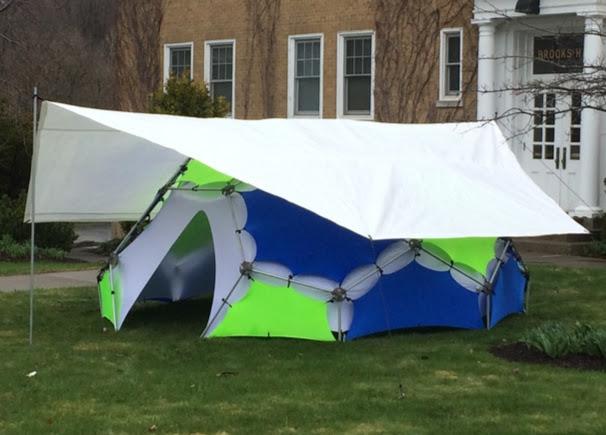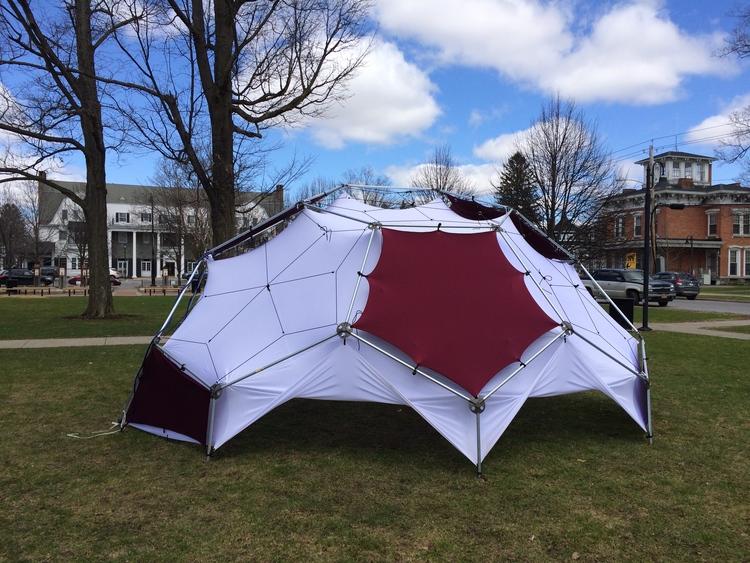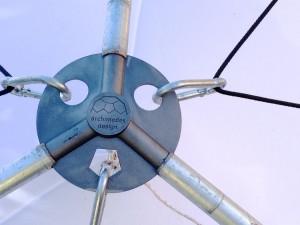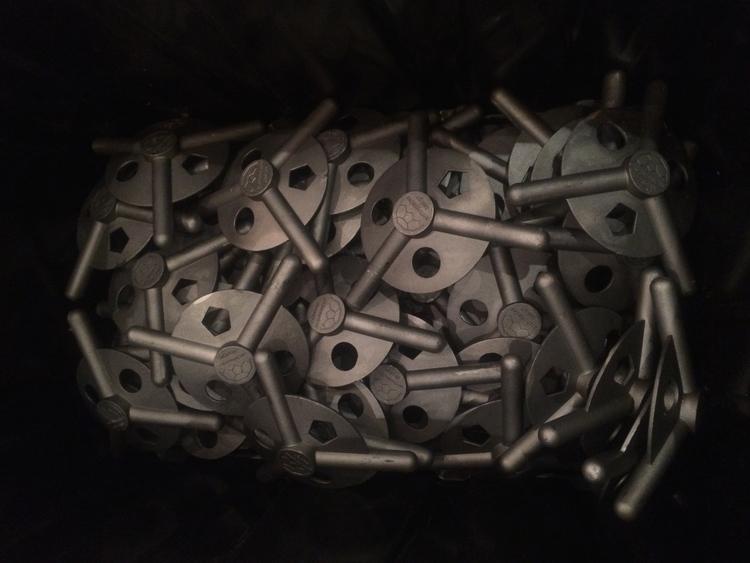There’s no better, more direct metaphor for the work that Michael Gates and Toby Vann of Archimedes Design do than the hub. It’s both the literal center or core of what they do and the driving force behind their venture. Gates and Vann are the founders of a truly community-centric, grassroots effort to provide one of life’s fundamental necessities: shelter. However, like most everything this creative duo does, they do it with an artfulness that blends form and function until the two are essentially indistinguishable from one another.
To say the dome structures they design and build arose from a grassroots ethos isn’t quite accurate. Quite literally, it’s dust, the fine–and some would say, insidious–dust of the Nevada desert. Longtime attendees of Burning Man, the annual mass gathering that has become legendary by now and whose fundamental principle of community infuses their work, Gates and Vann saw a need and they responded to it with the kind of creativity and energy that exemplifies the structures they stand behind–or beneath, as it were.
Drawing from a variety of resources, including 3D printing and 3D design, Gates and Vann began conceiving of shade structures that would withstand the intense conditions of the desert yet adhere to the temporal nature of the yearly festival. As any “Burner” knows, when you leave the festival, the environs of the infamous Black Rock City, you leave no trace.
When considering how to design something strong enough to provide shade from the sometimes relentless sun or the chill winds that cross the desert as soon as the sun has set, Gates and Vann began small. With slender cocktail straws, they constructed their first version of the structure that Gates explained is a “tesselated geodesic” dome.
“It’s basically icosohedral,” he elaborated. “It’s the classic dome structure with triangular facets approximating a hemisphere.”
Think jungle gyms, Epcot Center, Buckminster Fuller.
Although they began with more rudimentary construction methods, looking to tradition for examples like bent-pole supported structures, they realized that what they and their customers really wanted was something safe as well as sturdy. Bent poles can, after all, break. Furthermore, the shape of the dome itself spoke to the overall function of a shelter destined for the bustling but expressly temporary city that arises at the end of each summer. The city itself is laid out in concentric circles with lanes between camps and larger avenues leading to the Playa, the hub of life in Black Rock City.
It was that circular, inclusive civic structure that Gates and Vann wished to emulate with their domes. Knitting together the alternating hexagons and pentagons of the domes are star-like harness systems that can be adjusted to maintain the necessary tension to hold the poles, spokes in a sort of angular wheel, to the crucial hubs at each connecting point.
To assert that the hubs were the critical component of the Archimedes Design project is not an understatement. Gates recalled the trial-and-error process of the hub design:
“We were making our own hubs with the prototyping process and we realized through field testing that they were not strong enough. They were the weak link in the structure itself.”
Neither Gates nor Vann was a novice with respect to various methods of construction. They’d essentially built their own three-story Brooklyn home from the skeleton of the previous structure. They also knew that to produce a hub of the quality they had in mind they didn’t have to reinvent the wheel–or, more accurately, the hub. That’s when they turned to 3D printing to create a prototype for the cast hubs that they felt would meet the high structural standards of their domes.
While Gates had CAD experience and produced a preliminary design for the hub using SketchUp, they turned to an experienced designer who, based upon their specifications, used Rhino 3D to create a model to be 3D printed and, ultimately, cast. While they were aware that, as an ambitious but fledgling start-up they couldn’t afford to 3D print the hubs in metal and in great quantity, Gates and Vann knew that once they had a working, full-scale model of the new-and-improved hub, they’d have something concrete to show a foundry as well as potential investors. That’s been one of the essential selling points of 3D printing–its capacity to facilitate rapid, cost-effective prototyping for small businesses with big ideas. Gates and Vann took the 3D model, uploaded it to Shapeways, and a few days later the most ingenious iteration yet of their award-winning domes was in full-scale production.

The Day-Glo version, which Gates and Vann unveiled at taBURnac in Montreal this past winter
Since that time, Gates and Vann have sold multiple domes in three different sizes, customizing them to individual users via the colorful, spandex shade panels that stretch across the open expanses between hubs and supports, including a black light-enhanced version of beautiful, riotous color and a distinctive red-and-blue variation in honor of their recent appearance at Maker Faire 2015 in San Mateo, California. At last year’s Burning Man, Gates and Vann showcased several of their domes, which they delivered personally to fellow Burners and customers. In the spirit of community that so distinguishes the yearly festival, special delivery included a tutorial in constructing and deconstructing the domes.
While no traces of the eye-catching, smart, and efficient dome structures remained after the last bit of MOOP (“matter out of place” in Burning Man vernacular) was removed late last summer, word of Archimedes Design and the versatile, artful domes continued to spread. As Gates and Vann persist in perfecting the domes and branching out to create domes suitable for different environments and purposes, they welcome–in keeping with the festival’s philosophy of collective creativity–new ideas, novel iterations, forward-thinking investors, and, above all else, real-life stories of their domes as they inspire new communities and enterprises as creative as their own.
Let us know what you think of these designs in the 3D Printed Domes forum thread over at 3DPB.com.
Subscribe to Our Email Newsletter
Stay up-to-date on all the latest news from the 3D printing industry and receive information and offers from third party vendors.
You May Also Like
Profiling a Construction 3D Printing Pioneer: US Army Corps of Engineers’ Megan Kreiger
The world of construction 3D printing is still so new that the true experts can probably be counted on two hands. Among them is Megan Kreiger, Portfolio Manager of Additive...
US Army Corps of Engineers Taps Lincoln Electric & Eaton for Largest 3D Printed US Civil Works Part
The Soo Locks sit on the US-Canadian border, enabling maritime travel between Lake Superior and Lake Huron, from which ships can reach the rest of the Great Lakes. Crafts carrying...
Construction 3D Printing CEO Reflects on Being Female in Construction
Natalie Wadley, CEO of ChangeMaker3D, could hear the words of her daughter sitting next to her resounding in her head. “Mum, MUM, you’ve won!” Wadley had just won the prestigious...
1Print to Commercialize 3D Printed Coastal Resilience Solutions
1Print, a company that specializes in deploying additive construction (AC) for infrastructure projects, has entered an agreement with the University of Miami (UM) to accelerate commercialization of the SEAHIVE shoreline...



































